Due to its natural ingredients, Superisol resists the action of temperatures of 1000-1200°C. It is used as an insulating element in the construction of fireplaces and furnaces. It is used to make sheathing for chimneys, beams, side and rear walls in places where sources are installed. high temperatures.
When heated, Superizol does not emit unpleasant odors and does not change its structure. It is porous, smooth, easy to process and attaches to surfaces with ISOL GLUE, screws or system connections G-K. It is produced in the form of light gray plates with a thickness of 25-80 mm, a width of 610-1200 mm and a length of 1000-2440 mm.
Minerite
This is another non-combustible material. withstands temperatures of 150 ° C. It perfectly copes with its thermal insulation function and is used for such purposes:
- protection of walls in baths from high infrared radiation of stoves;
- creation of fire-resistant partitions, walls, ceilings, etc.;
- arranging ducts for exhaust and ventilation there.
Minerite from white or gray cement, which contains 90% of the total mass, includes mineral fillers: mica, limestone and cellulose fibers. Such a set of components provides the material with hardness, hydrophobicity and resistance to mold.
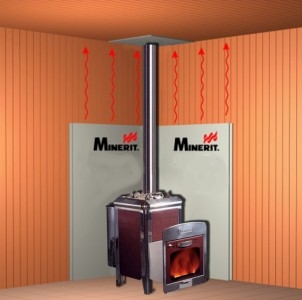
There is no asbestos in the boards of the EU countries. This speaks to their harmlessness. All of them belong to class M1, indicating the safety of products. They produce plates of standard sizes with a thickness of 8-10 mm with different colors. They cut well and are easy to attach.
GRENA-ISOL
Under this name, fire-resistant material is produced by the Czech company Grena. Products are heat-insulating panels made of vermiculite. It is based on layered silicates, which, when heat treatment and pressing acquire the following unique properties:
- heat resistance up to 1250° С;
- environmental friendliness;
- strength;
- durability.
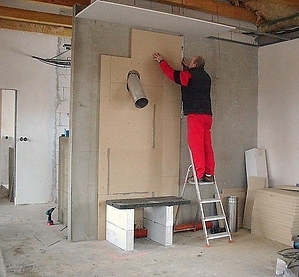
All these qualities make the most popular in relation to similar types of products. Being thin, durable and heat-resistant, the panels are used in the production of fireplaces as a casing material, as well as for insulating walls and chimneys. The panels are easy to process and attach to the surface.
Nichiha
The heat-protective decorative plate of the Japanese company Nichiha can be characterized in this way. It is intended for wall cladding in baths. The slabs have a relief surface and come on the market with dimensions of 1000×443×14 mm.
The material from which they are made is fiber cement. The basis of the product is a special fiber coated with durable ceramics resistant to high temperatures. The material does not contain asbestos, so it is absolutely harmless. All its qualities are confirmed by the relevant sanitary standards and certificates. The tiles are hydrophobic, do not change color and are very practical.
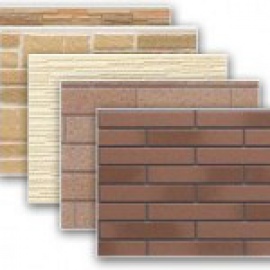
If the walls of your bath or room with a fireplace need to be protected from high temperatures, you will hardly find better material samples than those given here. Feel free to use any. Their quality is undeniable, and the recommendations are true.
interior decoration"data-essbishovercontainer="">Flame retardant interior panels are an ideal option for those homeowners who prefer to approach interior design not only from an aesthetic point of view, but also from the point of view of maximum security. In the construction market, such materials are presented in a fairly wide range of colors, shapes and sizes.
These types of panels are in perfect harmony with other finishing materials, so they can be used in the interior in various combinations. In addition, they are distinguished by high practicality in operation and ease of maintenance, as they are durable and easy to wet cleaning. But in fire hazardous situations, in case of overheating and the beginning of smoldering, this finishing material acts on self-extinguishing, preventing the fire from spreading throughout the premises.
When considering the issue of fireproof finishing, it is necessary to have an idea of the criteria by which the combustibility group of materials is determined. These evaluation parameters include the following factors:
- The rate of ignition of materials and the spread of fire.
- Toxicity of substances released during combustion.
- The ability to maintain a fire in an oxygen-free environment, that is, the ability to quickly extinguish the flame by cutting off oxygen access to it.
Ideally, a quality fire retardant material should score top marks on all three of the above. Many finishing boards used for finishing the premises of the house, made of heat-resistant materials, can be safely attributed to non-combustible products. However, in the assortment of shops there are often panels designated as slow-burning. Therefore, further it is worth considering how to make a choice:
- From the very name of the non-combustible finishing material, it becomes clear that the panels should not be subject to destructive changes under the influence of open fire, sparks, various chemical reactions, and be able to withstand high heating temperatures. Under such extreme conditions, no emission of gaseous by-products posing a risk to human health should be noted.
Such plates, in accordance with the regulatory documents GOST 30244-94 and SNIP 21-01-97, belong to the combustibility group "NG", that is, non-combustible materials.
- All other panels marked "G1", "G2", "G3" and "G4" are combustible finishing materials. The designation goes on increasing their vulnerability to fire. Materials from the last two groups in this series, "G3" and "G4", in fact, do not have any degree of security at all, that is, they are frankly fire hazardous, and according to current standards, they are unacceptable for interior decoration.
- Moderately and slightly combustible decorative plates can ignite from an open flame or strong overheating, but the material used for their manufacture or coating does not support combustion and prevents the spread of fire, that is, they can be called self-extinguishing in another way.
This group of finishing materials includes some wood-fiber and particle boards, familiar to everyone under the abbreviations fiberboard and chipboard. But this will be true only if the composition of the material for their manufacture includes flame retardant additives that prevent ignition and the spread of fire. Existing rules allow moderately combustible ("G2") and slightly combustible ("G1") finishing materials for interior work.
You should not even consider purchasing those decorative panels, in the documents for which the marking of their flammability group is not at all affixed. Firstly, this largely indicates the low responsibility of the manufacturer and the non-compliance of materials with standards. Surely, the quality of such products will also not be up to par. And secondly, the issues of ensuring fire safety are not the area where “amateur activity” is allowed, that is, it is necessary to have complete certainty in this matter.
The combustibility of finishing boards depends primarily on the basis on which they are made. Yes, cladding decorative panels are made from inorganic and organic raw materials:
- Organic base types include wood, which is used in the production of plywood, chipboard and fiberboard. Most of these products are combustible, but some of them contain flame retardants, which make the panels more resistant to fire, that is, capable of self-extinguishing. However, it should be noted that decorative products from this raw material, even protected by special additives, can withstand high temperatures not indefinitely, but only for a certain, and rather limited period. Therefore, if you do not stop exposing them to open fire in time, then the material will definitely catch fire.
- Non-combustible panels are made from various inorganic mineral components of natural origin. It is to such materials that the following presentation will be devoted.
General information about non-combustible finishing panels
The main characteristics and advantages of non-combustible panels
non-combustible finishing panels made of different materials have quite similar General characteristics. Therefore, in order not to be repeated in the future, it makes sense to consider them in advance.
So, the following features can be attributed to such common advantages of this entire group of materials:
- Due to the fact that the panels are made from inorganic raw materials, they are not subject to biological damage by mold and fungus.
- All plates, no matter what material they are made of, are easy to install on a frame crate or on a pre-prepared, leveled wall.
- In the production of plates, raw materials are used that do not emit toxic fumes in any operating conditions, so they can be called environmentally friendly products.
- The protective coating applied to non-combustible plates perfectly resists high humidity in the room, lends itself well to regular care, including with the use of household detergents.
- All finishing panels are produced in a wide variety of colors, which allows you to choose the best option that is most suitable for interior design, conceived in a particular style.
- Like all panel materials used for wall and ceiling decoration, their non-combustible varieties also perfectly hide all the flaws of the main wall and level its surface.
- Non-combustible panels with an outer layer of decorative coating practically do not need additional finishing.
- All types of non-combustible facing boards have heat and sound insulating qualities. These parameters depend on the thickness of the base material of their manufacture, as well as on the thickness of the decorative and protective layer, which in some types of panels can be up to 1.5 mm and is applied on one or both sides of the panels.
- When carrying out installation and finishing works, a minimum amount of construction debris and dust is formed in the premises. There are no "wet" processes
- Most often, the decorative top layer, in order to avoid damage during transportation, is sealed with a protective film, which can be easily removed after installation is completed.
Non-combustible panels made of different materials can vary in sheet size and thickness, which can vary from 3 to 50 mm. This is explained by the fact that such materials can be used in a variety of areas, both internal and external finishing of the building, with different requirements for the surface strength of the cladding. For interior wall decoration, products with a thickness of 3 to 15 mm are most often used.
The main applications of non-combustible panels
For interior decoration, and in different areas of an apartment, house or premises public buildings, almost all types of non-combustible panels are suitable, but besides this, some of them may well be used for facade cladding. For typical use cases for internal works include the following options:
- They are often used to decorate living rooms in apartments decorated in one of the directions. modern style"minimalism".
- Such plates are excellent for use as "panels", that is, the lower, most exposed areas of the walls of hallways, corridors and kitchens. However, nothing prevents and finish the walls along the entire height.
- Panels of this type will perfectly fit into the interior of children's rooms, especially since for this purpose you can choose bright, well-matched colors.
- In a residential environment, some non-combustible panels with a certain flexibility are used to decorate arched openings. In addition, any of the varieties of such materials is suitable not only for wall decoration, but also for the construction of light frame partitions.
- These finishing materials are very often lined with niches, slopes of door and window openings - a practical and easy to install solution.
- One of the "classic" examples of application is the interior decoration of hotels, restaurants and offices. This is all the more important because in such institutions there are always increased requirements for ensuring fire safety in the premises themselves and on evacuation routes.
- Often, non-combustible panels of small thickness are used to create multi-level ceiling structures.
- An interesting application - some varieties of this material are successfully used for the manufacture of individual parts of cabinet furniture.
- Another area of use is the lining of non-standard interior elements, such as decorative fireplaces, podiums and others that need to be distinguished from the general background.
Varieties of non-combustible panels according to the material of manufacture
As mentioned above, non-combustible materials are selected as the basis for panels of this type, which include gypsum, vermiculite, glass magnesite, calcium silicate composition and others. To have an idea of what these products are, it is necessary to consider those that are most often used for interior decoration of residential premises.
Gypsum vinyl panels
Gypsum vinyl finishing panels or gypsum vinyl plus cardboard is a sheet product, the main part of which consists of a non-combustible gypsum layer. This carrier layer is lined on both sides with cardboard sheets, and then its front side is also covered with a special protective and surface-decorating vinyl film.
The density of the total cardboard-vinyl layer of the gypsum board coating is about 250÷300 g/m². This layer has increased wear resistance, so the finishing material can be used even in rooms with a high intensity of movement of people and, therefore, a possible abrasive load.
The installation of this material on the walls is carried out using a special system of metal profiles, some of which can also simultaneously serve as decorative elements in the design of the walls of the room.
One of the manufacturers representing on the Russian market similar gypsum panels for interior decoration with the original Durafort vinyl coating is the Dutch company BN International. The products of this brand are quite popular among professional finishers, as they have excellent performance and decorative characteristics.
Thanks to a reliable moisture-resistant coating having a thickness of 0.4 ÷ 0.47 mm, the plates are practically not subject to mechanical damage, abrasion, and may well be subjected to regular wet cleaning. In addition, such a panel coating well withstands not only conventional detergents, but also such aggressive compounds as various acids, alkalis, gasoline and ammonia.
Gypsum vinyl boards can be produced with double-sided or single-sided coating. The first option is used for the construction of light thin decorative partitions. The second is used for wall cladding or the construction of a multi-layer structure blocking the room - with external decorative walls and an internal cavity, which is most often filled with sound and heat insulating materials. Usually, basalt mineral wool is used as the inner layer.
Another important advantage of vinyl flooring is its antibacterial qualities, as they eliminate the risk of mold colonies on the surface of the lining.
This kind of material for finishing interior walls is produced in the widest range, that is, the panels can have a smooth or textured surface, be made in various tint options, which ultimately allows you to choose the appropriate option for a particular interior solution.
Vinyl coating "Durafort" can imitate the pattern and color variety of natural materials on the surface of the plates, such as natural leather, stone, wood, as well as the structure of fabrics or Venetian glass. The manufacturer guarantees the shelf life of the original decorative look of their products for at least eight to ten years.
A few words must also be said about the shortcomings of this finishing material, if only so that they do not come as a surprise when purchasing gypsum vinyl panels, during finishing work and during the further operation of the finished premises. These factors include:
- A fairly high price for this type of finishing material;
- Relative fragility, since if the rules of transportation or installation work the plate may break;
- Gypsum vinyl panels of the specified manufacturer can have only two thicknesses: 12.5 mm, if there is a coating with a decorative layer on one side, and 13 mm, if it is applied on both sides of the plates;
“In addition, Durafort-coated products are produced in only two sizes - these are 3000 × 1200 and 2500 × 1200 mm. However, it should be noted that the sizes of plates and other manufacturers are also by no means very diverse. Therefore, if the wall decoration is planned with colored squares or rectangles, they will have to be cut out and adjusted to the crate on their own.
Now, knowing the areas of use of non-combustible gypsum vinyl panels for interior decoration and their main characteristics, it is necessary to clarify the points that limit their use or impose Additional requirements for work:
- This type of slab is not recommended for use in rooms with pronounced high humidity, such as basements, bathrooms or baths. Gypsum itself absorbs moisture very well, which can lead to gradual damage to the finish.
- Almost always, when mounting panels on a wall, they have to be cut to the desired size. In this case, the edge of the plates must be protected by sealing and carefully covering with masking tape.
- Making out the slopes of door and window openings with this material, it is imperative to use a waterproof and transparent adhesive composition to fasten them.
Glass-magnesite panels (SML)
Glass-magnesite or glass-magnesium sheets (plates) LSU are made from volcanic perlite and magnesium compounds, which initially, by their nature, are non-combustible.
The glass-magnesite panel consists of several layers, the main of which is a plate of perlite and magnesium. Then applied to it decorative layer from acrylic paint, and protective, consisting of a special varnish or plastic, that is, in fact, the material is laminated.
Several variants of glass-magnesite panels are made, differing from each other in some characteristics, depending on the layers of which they consist:
- "Premium" with a one-sided decorative layer - wall panels with a size of 2440 × 1220 mm, a thickness of 6, 8, 10 or 12 mm and a mass of 18, 24, 30 and 37 kg, respectively, as well as ceiling panels with a size of 600 × 600, 3 and 6 mm thick, weighing 1.35 and 2.17 kg.
3 - protective paintwork.
This type of panels is produced in a wide range of shades and textured surfaces. This makes it possible to implement any design solutions and achieve the desired effect of the design of the room.
- "SML-Premium" with double-sided reinforcement with fiberglass mesh has the same dimensional parameters as the previous version. Such panels also have a one-sided paint coating, but have greater mechanical strength and flexibility due to the reinforcing mesh.
1 - glass-magnesite plate "SML-Premium";
2 - a special external reinforcing layer based on magnesium oxide and chloride and special fillers;
3 - fiberglass reinforcing mesh;
4 - protective and decorative acrylic paintwork.
- Premium boards with HPL plastic coating applied on both sides of the base. They also have a size of 2440 × 1220 mm, a plastic coating thickness of 0.8 mm and a weight, depending on the total thickness of the sheet - 31, 36 or 41 kg.
1 - glass-magnesite plate "SML-Premium";
2 - a layer of HPL-plastic with a decorative coating (on the front side of the material);
3 - protective laminating layer;
4 - adhesive compensation layer;
5 - protective HPL-plastic coating on the back of the sheet
Double-sided plastic coating expands functionality panels and their application in different areas, as it makes products more durable and avoids deformation processes of the base material with increasing temperatures and humidity. Laminated plastic coating is fire resistant, inert to aggressive environments, including chemical attack. This type of panels is highly environmentally friendly and surpasses even other variants of the same Premium class LSU-slabs in this parameter.
- Panels "Premium", having a painted decorative layer according to the "RAL" table. The sheet size is 2440 × 1220 mm with a thickness of 3, 6, 8 or 10 mm and a weight of 11, 22, 28 and 34 kg, respectively.
- Panels with imitation of wood texture pattern of various species with the following parameters: size 2440 × 1220 mm, thickness 3, 6, 8, 10 and 12 mm and weight 11, 22, 28, 34 and 41 kg. Panels with a monochrome embossed surface have the same linear and weight parameters.
The main characteristic features of glass-magnesite panels include the following qualities:
- This type of material compares favorably with other non-combustible panels increased level fire safety, since plates of this type can ignite only at temperatures exceeding 1000 degrees, which is comparable in terms of heat resistance to concrete and steel.
- Premium glass-magnesite boards, especially reinforced with fiberglass reinforcement, have good flexibility compared to gypsum vinyl panels. They are able to withstand bending stress of 10÷13 MPa, which makes it possible to use them for designing arched openings and complex multi-level structures. suspended ceilings.
- Unlike gypsum vinyl panels, glass-magnesite boards have increased moisture resistance, and therefore can be safely used in rooms with any level of humidity, including both basements and bathrooms. This type of finishing material does not swell or delaminate, and also does not lose its original qualities, so the rooms decorated with it do not lose their aesthetic appeal for a long time and do not need to be repaired.
- The advantages of glass-magnesite sheets include the fact that during operation this finish does not emit fine dust particles that are dangerous for people with a predisposition to allergic reactions.
- The scope of these panels in construction is practically unlimited, since they are not only non-combustible, but also environmentally friendly material, and under any created conditions do not emit fumes hazardous to humans or the environment. Therefore, they are widely used for wall decoration in both residential and public buildings.
- These panels are perfect for cladding porches apartment buildings, as they have anti-vandal strength. They are difficult to scratch, they do not break under impact and other mechanical influences, which is especially important for objects with high traffic intensity and a high probability of shock or abrasion load.
In addition, the panels often have a glossy surface, which is able to enhance lighting, which is also important for fairly dark hallways.
Wall non-combustible panels SKL
Another option for a non-combustible finishing material is SKL panels - this abbreviation stands for "calcium silicate sheet". Such boards are made from mineral raw materials such as calcium silicate, cement, quartz, lime and cellulose fibres. All of these components are environmentally friendly materials that do not emit toxic substances when heated, as well as during the entire operation of the finish.
Except monolithic sheets, on sale you can find perforated panels, which are intended mainly for finishing the ceiling surface. However, some homeowners successfully use them for wall decoration.
Calcium silicate boards are divided into classes - these are "premium" and "standard", as well as perforated and solid, laminated or uncoated. Characteristics various kinds somewhat differ from each other.
SKL "Premium"
This class of non-combustible boards is used both for interior decoration and for facade wall cladding. The panels have increased density, strength and moisture resistance, and as the end result - excellent durability. This quality is also facilitated by the reinforcement of the base layer with fiberglass mesh.
The standard dimensions of premium class panels are 2440 × 1220 mm, and the thickness and corresponding weight of the material sheets are presented in the table:
| Panel thickness, mm | Panel weight, kg | Specific weight of the panel, kg/m² |
|---|---|---|
| 3 | 9,9 | 3,3 |
| 6 | 19,8 | 6,7 |
| 8 | 26,4 | 8,9 |
| 9 | 29,7 | 10,0 |
| 10 | 33,0 | 11,1 |
| 12 | 39,6 | 13,3 |
| 15 | 49,5 | 16,6 |
| 16 | 52,8 | 17,7 |
| 18 | 59,4 | 20,0 |
| 20 | 66,0 | 22,2 |
At the same time, it should be taken into account that small discrepancies in dimensional and weight parameters are quite acceptable, which can be: in thickness ± 0.2 mm, and in weight ± 0.07 kg.
Detailed technical and operational characteristics of premium class products and their hygiene certificate confirming compliance with all sanitary standards, as well as a quality certificate from the manufacturer, must be available from the seller of the goods.
To distinctive features This finishing material, which you can check yourself, includes the following features:
- The surface of the plates with a reliable protective coating has a high strength, therefore, it should not be subject to mechanical damage, such as denting or scratching. This can be checked at the store by pressing on the material and trying to scratch it. Such an experiment is usually carried out on samples that are displayed on demonstration stands.
- The obligatory presence of a perfectly smooth coating on one side of the sheet is checked, and its reverse, back side is usually rough. The material must be solid and show no signs of crumbling.
Calcium-silicate slabs of the "premium" class during private construction can be used in various areas of work:
- Finishing of attic and other enclosing structures.
- flooring under roofing material in rafter system- as a continuous crate.
- Construction of interior partitions.
- Finishing of evacuation exits and fire-prevention premises.
- Cladding of walls and ceilings in rooms with high humidity.
- Arrangement of false ceilings of any degree of complexity.
- Finishing the slopes of door and window openings.
- Installation of fixed formwork during the construction of foundation walls and plinth.
- Flooring, as a basis for further finishing.
When carrying out installation work, the panels are cut in the same way as drywall, that is, along the front side of the plate, along the marking line, they are carried out with a sharp knife. Then the incision is aligned with the edge of the table and evenly pressed down on the protruding part of the surface. You can also cut the panels with an electric jigsaw or hacksaw.
When fixing panels to a wall or frame using self-tapping screws, it is recommended to pre-drill holes for them, otherwise the premium class sheet may crack, as it has an increased density. Holes should be drilled with a pobedite drill or a crown drill if necessary to cut big window, for example, under the socket or switch.
Slabs SKL "standard"
The "standard" panels can be immediately distinguished from the "premium" class, since their surface does not have a perfectly smooth surface, and the reinforcing mesh can even be applied directly to the surface on both sides.
The tensile strength and frost resistance of the "standard" panels are much lower, and the hygroscopicity is higher. Products are produced in light gray or beige color, emit a ringing sound when tapped on them, about the same as that of slabs made of Portland cement. The dimensions of the panels are 2500×1250 mm, and the thickness is 6, 8.10 and 12 mm.
AT finishing works Indoors, such material practically does not find application.
Laminated panels SKL
Calcium-silicate boards with a laminated surface can have coatings of various decorative properties that imitate metal, stone, leather, wood of various species, or simply painted in different color shades according to the RAL scale. over decorative layers the boards are covered with a protective glossy or matte film coating, which ensures the durability of the finish.
Laminated boards are intended for both interior and exterior decoration, so we can safely say about them that their scope is not much limited. This type of SKL, in addition to its special decorative effect, has all the positive characteristics of SKL-“premium” mentioned above, and is excellent for wall cladding in any residential, public or utility rooms.
Installation work on the installation of non-combustible finishing panels
All non-combustible panels are mounted on the walls in two ways - with fixing to the frame, or with fixing directly to the surface, that is, using frame or frameless technology. To determine which installation option is best suited for a particular surface, it is advisable to familiarize yourself with both cladding methods.
Installation of panels on a frame structure
To create a frame and fix the panels on it, special steel or aluminum profiles are used to cover the joints and corner parts of the junction of the plates. Moreover, the outer profiles are painted with polymer compositions selected according to the RAL catalog, which allows you to perfectly combine the color of the frame and the mounted plates, creating a surface completely protected from external influences.
The metal parts of the frame are standard sizes along the length, which are 3000 mm for an aluminum profile, and 2500, 2700, 3000, 3300, 3600 mm for those made of galvanized steel.
To understand in which area and for what this or that frame element is used, it is recommended to familiarize yourself with the installation scheme presented for the sample and the table below. They show the main connecting nodes used to install non-combustible finishing panels.
| Profile design | Name and scope of the profile |
|---|---|
| The PS profile is a common rack profile, used, among other things, for drywall work. It creates the supporting base of the frame - it is these racks that are attached to the wall surface. The PS profile is completely hidden by the cladding, that is, its appearance does not matter - the usual galvanized version can be used. |
|
| The L-profile is intended for joining plates at internal corners. | |
| The F-profile is used to neatly and evenly connect panels at external corners. |
The peculiarity of using these profiles for mounting plates is that the panels are not damaged when they are fixed, but are clamped between two profiles. The profiles themselves are attached to the guides of the frame, assembled from the PS profile, installed vertically or horizontally and fixed with metal screws. Due to the fact that the design is not only reliable, but also easily disassembled, access to all communications hidden behind the panels will always be provided, since it will not be difficult to remove the panel fixed in this way.
Installation of the facing structure is carried out in stages, in the following order:
- The first step is to mark the wall for fixing elements future design, while taking into account the width of the panels. A prerequisite is the presence of a PS profile exactly along the junction line of adjacent panels.
- Further, horizontal guide profiles are fixed to the wall with dowels to the ceiling and floor, as well as along the side walls. These profiles should determine the future plane of the cladding.
- After that, in the ceiling and floor guide profile, perpendicular to them, that is, strictly vertically, PS profiles are mounted, which become frame guides. They are installed in increments, which is calculated depending on the planned width of the panel, and fixed to the wall with dowels or with straight hangers - if an indentation is required, for example, for laying insulation or soundproofing material, or the wall has a curvature.
- In the next step, the front parts of the PS profiles are degreased and dried. After that, pieces of double-sided construction adhesive tape 650 ÷ 700 mm long are applied to them. They are glued in increments of 200 ÷ 250 mm.
- Installation of profiles and non-combustible panels starts from the corner of the structure. Therefore, an L-profile is fixed to the PS-profile installed in the corner part of the frame with the help of self-tapping screws. A decorative plate is inserted into it and pressed against the adhesive tape pasted on the PS profile. In this case, it should be taken into account that the distance between the floor and the bottom of the sheet should be at least 10 ÷ 20 mm. To maintain this clearance, it is best to place wooden bars under the sheet that have the required thickness.
- Further, an “omega” profile for joining is superimposed on the installed and fixed plate, it is also first strictly vertically fixed on adhesive tape, and then screwed to the PS profile with self-tapping screws in increments of 400 mm through the central channel.
- After that, another finishing plate is installed under the second “wing” of the “omega” profile and is also pressed against the adhesive tape of two PS profiles fixed on the wall along the edges of the panel. Work continues in the same order until the entire wall is covered with cladding.
- The next step, the channels of the "omega" profiles, through which they were screwed to the frame, are closed with Pi-profiles (plugs).
- External corners are made with F-profiles, internal - with L-profile. How they are installed can be well seen in the above installation diagram.
Frameless method of mounting non-combustible panels
This technology of fixing the boards can only be implemented if the surface to be coated is perfectly level, as the boards will be glued directly to the wall.
The process of mounting panels without using a frame is carried out in the following sequence:
- First, the wall surface is cleaned of dust, primed and dried.
- Further, if it is planned to use the aluminum profiles discussed above to fix the panels, then the wall must be marked. It is taken into account that there should be a distance between the plates in order to install the “omega” docking profile, which in this case will be fixed to the wall, pressing itself against it cladding panels. The rest of the installation follows the principles of frame technology.
- If the plates are joined together without additional fasteners, then double-sided adhesive tape is glued to the wall or “liquid nails” glue is applied in stripes. Adhesives are applied vertically so that they fall on the edges of the plates, and plus, horizontally in increments of 600 ÷ 700 mm.
- Then, the plates are exposed and pressed against the prepared surface with the applied glue. Between them it is necessary to leave a gap of 2 ÷ 3 mm, for the thermal expansion of the material. In the future, it can be filled with putty to get a smooth surface of the cladding.
It is clear that most often this installation method is used when plates without a decorative coating are selected. In principle, this is not even a finish in the direct sense of the word, but rather one of the preliminary stages of preparation for it, associated with leveling the wall surface. But on this non-combustible flat surface, it is already possible to carry out any conceived finish.
* * * * * * * * *
In conclusion, it should be noted that many owners of houses and apartments do not even assume the existence of non-combustible panels for interior decoration. And some of those who are aware of the existence of such products, for some reason do not seriously consider them as a finishing material for residential premises. And it’s completely in vain, since the panels have many obvious advantages over other types of wall cladding.
Choosing non-combustible decorative boards, you can solve several problems that arise during the repair process “in one fell swoop”. This will significantly reduce the time for repair work, save yourself from large-scale cleaning, hide some engineering communications behind the cladding, additionally soundproof and insulate the walls, and also save some money, since in most cases additional finishing is no longer needed.
At the end of the publication, we suggest watching an interesting video about the advantages of non-combustible finishing panels:
Video: Profitable solution - decorative non-combustible panels for interior decoration
When creating furnaces and other heating structures, sheet materials are needed to protect surrounding objects. This is due to the strong heating of the combustion chambers. To prevent fires from various composites, sheathing of stoves and fireplaces is made. Also, the cladding has an aesthetic appearance. For example, the mineralite refractory plate is used for facing various heating structures.
Types of materials
One of the most popular materials used for the exterior of various furnaces are metal and asbestos. Asbestos sheets are able to withstand prolonged heating. The temperature can rise up to +500 degrees. Such materials poorly conduct heat, which has a positive effect on the level of safety of the furnace. They also have high strength. They are used in the arrangement of heat-resistant walls.
Important! Steel plates are usually placed in front of the sauna stove doors.
Protective screens made of steel sheets are more often used for combustion units when insulating side walls. They are installed 5 cm from the heating equipment. Due to this, its thermal radiation is reduced.
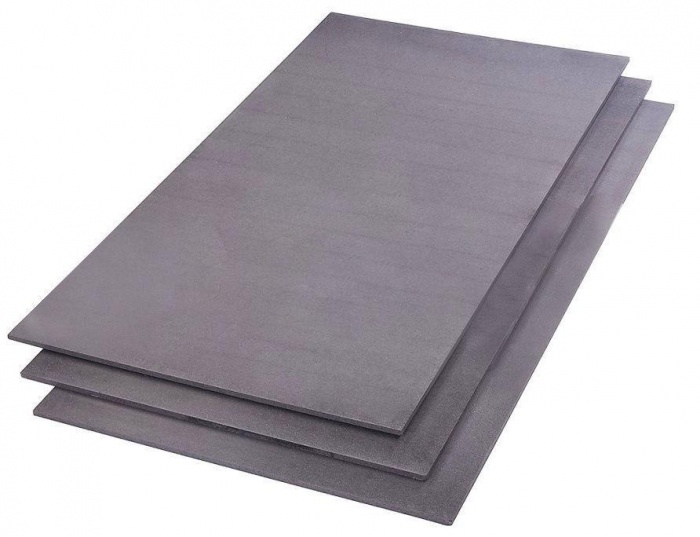
This increases the safety level of heating devices. Installed protective screens pretty simple. They are mounted on special legs.
Fire-resistant skins are heat-reflecting elements that are equipped with a snug fit of the building wall to the side of the heating device. Thus, the surrounding space of the apartment is protected from heating and ignition. Fireclay plates are fire-resistant materials made from a special powder.
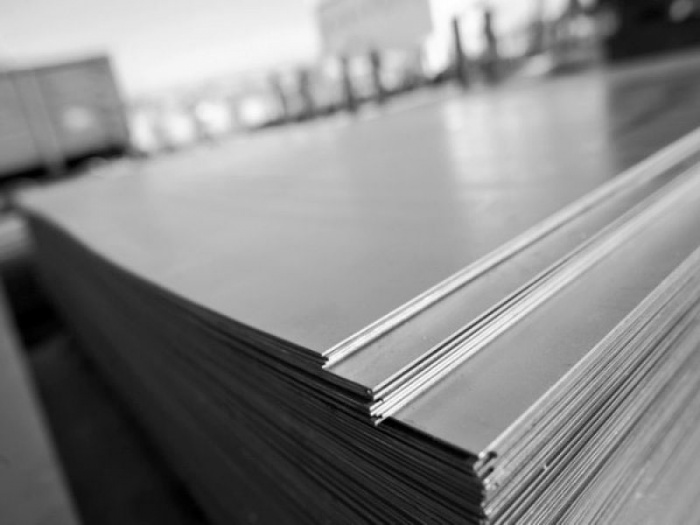
Reflective lining
Quite often for protection various items from heating, sheathing is used, which consists of non-combustible heat-insulating composites and refractory sheets. Fire-resistant materials are installed on top of the thermal insulation layer. For such cladding, it is better to choose stainless steel. Galvanized models emit hazardous substances during heating.
To increase the effectiveness of protection, the stainless steel sheet is polished to a mirror state. So heat rays will be reflected from the metal. The wall heats up noticeably less.
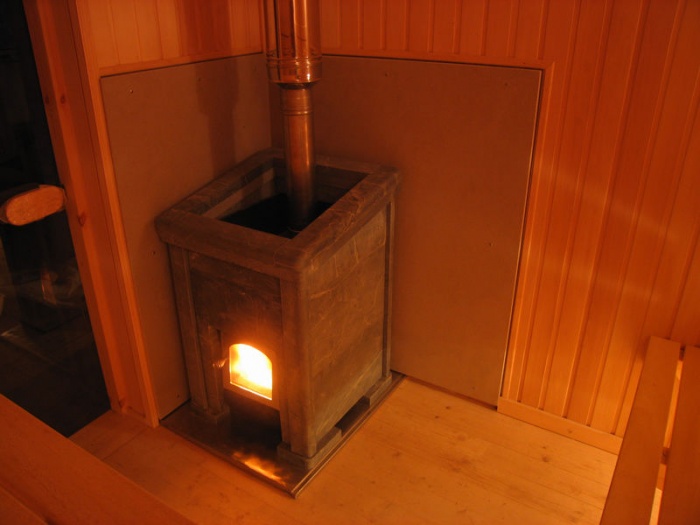
Many manufacturers offer a range of OLMs for lining furnaces:
- asbestos cardboard, which has established itself as a strong and durable material;
- basalt cardboard, providing not only good heat, but also sound insulation;
- minerite - such material is also quite widely used to create protective screens.
There are other materials for sheathing, which, in addition to protective, also have decorative properties. For example, fireclay slabs are in demand for lining furnaces.
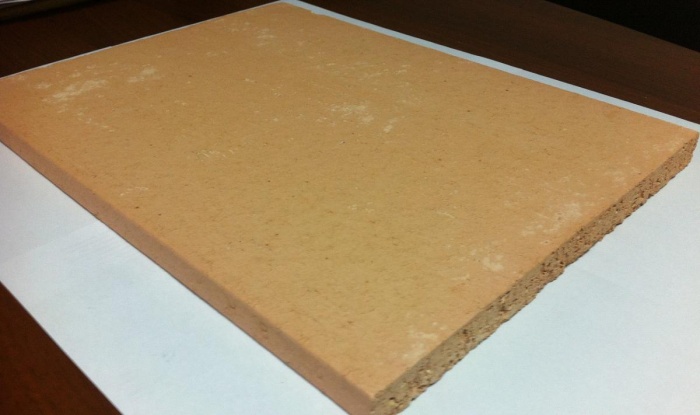
Sheathing with cladding
To create an attractive appearance of furnace equipment, various materials with decorative properties are used. Among them are:
- glass-magnesium sheet- it is made of fiberglass;
- minerite - it is also characterized by increased moisture resistance;
- fire resistant drywall- it retains its properties even with strong heating.
Such materials provide sufficient protection for objects in the immediate vicinity of the heating device.
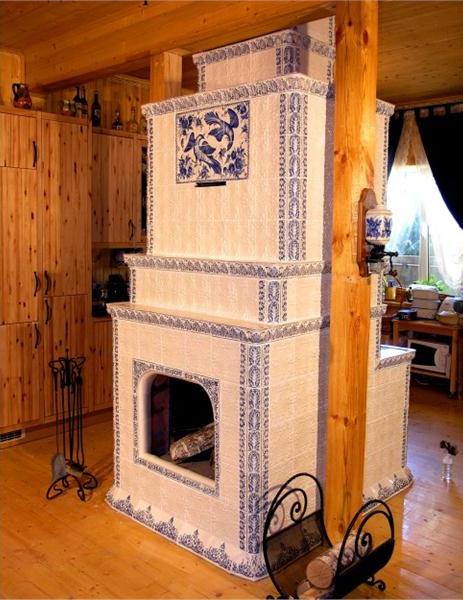
There are also several other varieties of refractory boards. The most popular are terracotta tiles. Such material is made of fired clay. Products are quite durable, and also have high heat resistance. Terracotta tiles can have different color shades.
Another interesting option for lining the furnace is clinker refractory boards. Outwardly, they resemble facing bricks. They are also made from clay. Clinker tiles are characterized by high density.
Porcelain stoneware is also used for lining furnaces quite often. Such a tile often imitates a natural stone. The color palette of the material includes all shades.
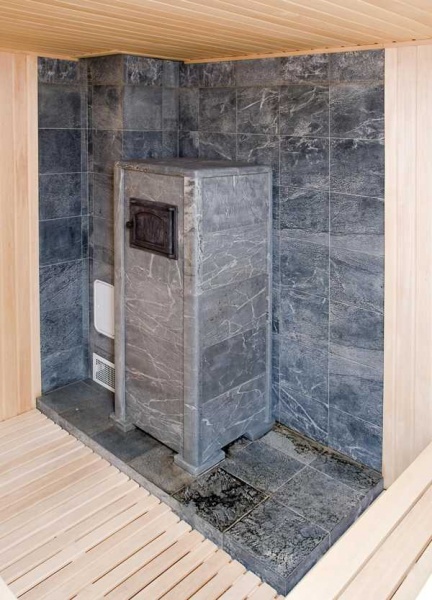
Vermiculite boards
Competent selection of material for lining the furnace should be carried out taking into account the type of heating structure. Vermiculite boards are considered the most effective. They are used for wall cladding, near which the heater is located. They have many advantages that can be attributed to fireclay plates.
Vermiculite boards have a number of advantages:
- high environmental friendliness;
- excellent degree of sound insulation;
- high thermal stability;
- fire resistance;
- aesthetic appearance.
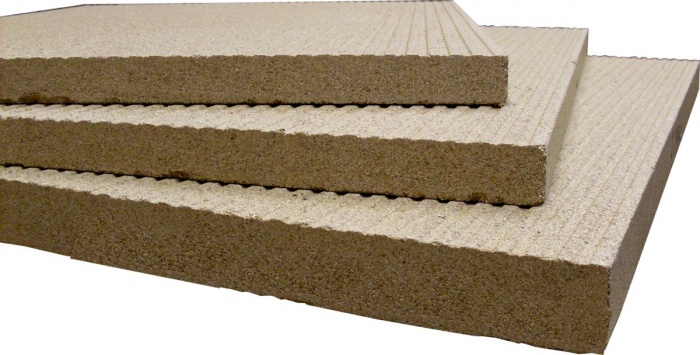
These boards are used for various purposes. This is due to the presence of a large number useful properties such material. Applications:
- thermal insulation for stoves and fireplaces;
- for fire protection;
- to increase the fire resistance of various objects located in a room with a heating device.
Vermiculite boards are quite simple and easy to install. Such work does not require professional training. They can finish the oven from different sides. The use of such materials is an effective solution for finishing furnaces.
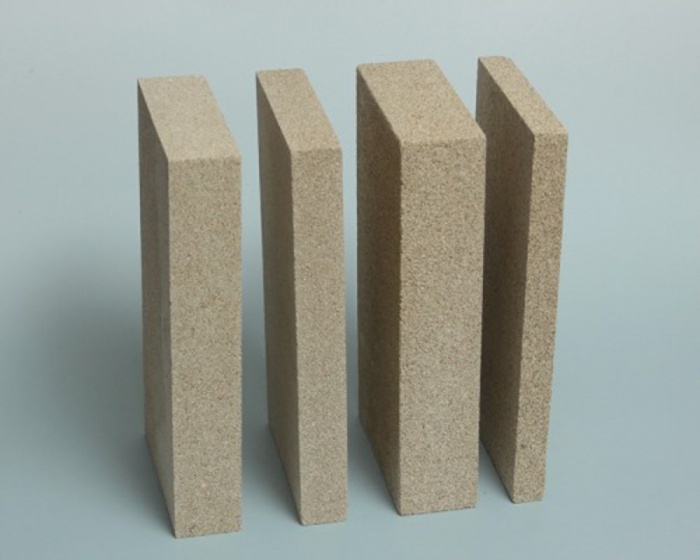
All models of fireclay plates are modern products High Quality. In addition to fire protection, they are able to give the heating device strength, as well as protect it from chemical influences.
Along with vermiculite boards, Supersil products are increasingly being used today. They are made from silica. Coatings are used for thermal insulation of any furnaces. The high performance properties of the material are due to the fact that it was originally developed by the Ministry of Defense.
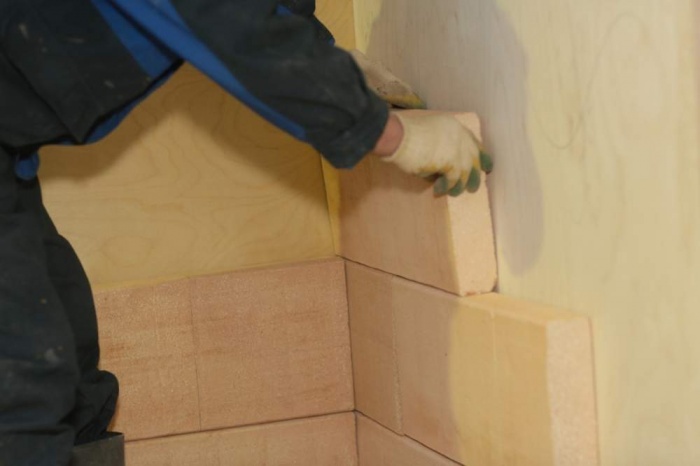
Plates can withstand exposure to temperatures up to 1200 degrees. The thickness of the plates is 0.6 cm. For some time, the material was used in testing spacecraft. One of the main advantages of the material is its elasticity. This property makes it possible to cover surfaces of various shapes.
Flam slabs
Flama refractory boards are made from fiber cement. They are highly fire resistant. Used for shielding stoves and fireplaces, as well as various heating equipment. The products are in demand in the construction of fire-resistant partitions in those rooms for which high fire safety requirements are imposed.
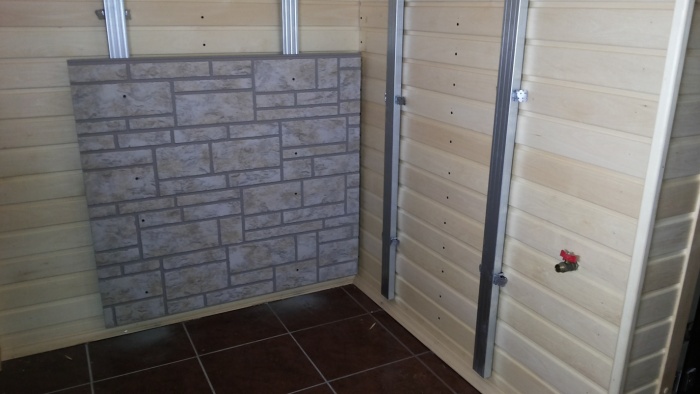
Plates of this brand also have high impact resistance. They are not affected by moisture, and are also resistant to fungi and mold. Flam slabs do not emit harmful substances into the atmosphere. They can also be dyed.
The protective sheathing must be carried out with the obligatory observance of the ventilation gap. Due to this, the wall does not heat up. In addition, thanks to the use of cladding, it is possible to disguise protective layer, as well as make trim in the style of the room.
Chamotte plates are quite often used in the arrangement of speeches and fireplaces. They provide excellent protection against high temperatures.




















